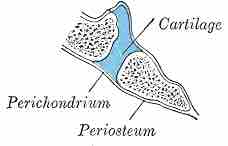Cartilaginous joints are connected entirely by cartilage (fibrocartilage or hyaline). Cartilaginous joints allow more movement between bones than a fibrous joint but less than the highly mobile synovial joint. The joint between the manubrium and the sternum is an example of a cartilaginous joint. This type of joint also forms the growth regions of immature long bones and the intervertebral discs of the spinal column.
Where the connecting medium is hyaline cartilage, a cartilaginous joint is termed a synchondrosis or primary cartilaginous joint. A synchondrosis joint is the first sternocostal joint (where the first rib meets the sternum). In this example, the rib articulates with the sternum via the costal cartilage. The rest of the sternocostal joints are synovial plane joints.
A temporary form of joint called an epiphyseal (growth) plate, is one where the cartilage is converted into bone before adult life. Such joints are found between the epiphyses and diaphyses of long bones, between the occipital and the sphenoid bones, and during the early years of life, between the petrous portion of the temporal and the jugular process of the occipital bone. The epiphyseal plate is a hyaline cartilage plate in the metaphysis at each end of a long bone.
The epiphyseal plate is found in children and adolescents. In puberty, increasing levels of estrogen, in both females and males, leads to increased apoptosis of chondrocytes in the epiphyseal plate. Depletion of chondrocytes due to apoptosis leads to less ossification, and growth slows down and later stops when the cartilage has been completely replaced by bone. This process leaves only a thin epiphyseal scar that later disappears. In adults who have stopped growing, the plate is replaced by an epiphyseal line. Those with achondroplasia (a form of dwarfism) have premature closure of the epiphyseal growth plates, which results in shorter than average arms and legs.

Synchondroses
Section through occipitosphenoid synchondrosis of an infant, including the cartilage, perichrondrium, and periosteum.